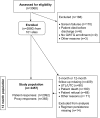Secondary preventive medication persistence and adherence 1 year after stroke
- PMID: 21900638
- PMCID: PMC3265047
- DOI: 10.1212/WNL.0b013e31822f0423
Secondary preventive medication persistence and adherence 1 year after stroke
Abstract
Objective: Data on long-term use of secondary prevention medications following stroke are limited. The Adherence eValuation After Ischemic stroke-Longitudinal (AVAIL) Registry assessed patient, provider, and system-level factors influencing continuation of prevention medications for 1 year following stroke hospitalization discharge.
Methods: Patients with ischemic stroke or TIA discharged from 106 hospitals participating in the American Heart Association Get With The Guidelines-Stroke program were surveyed to determine their use of warfarin, antiplatelet, antihypertensive, lipid-lowering, and diabetes medications from discharge to 12 months. Reasons for stopping medications were ascertained. Persistence was defined as continuation of all secondary preventive medications prescribed at hospital discharge, and adherence as continuation of prescribed medications except those stopped according to health care provider instructions.
Results: Of the 2,880 patients enrolled in AVAIL, 88.4% (2,457 patients) completed 1-year interviews. Of these, 65.9% were regimen persistent and 86.6% were regimen adherent. Independent predictors of 1-year medication persistence included fewer medications prescribed at discharge, having an adequate income, having an appointment with a primary care provider, and greater understanding of why medications were prescribed and their side effects. Independent predictors of adherence were similar to those for persistence.
Conclusions: Although up to one-third of stroke patients discontinued one or more secondary prevention medications within 1 year of hospital discharge, self-discontinuation of these medications is uncommon. Several potentially modifiable patient, provider, and system-level factors associated with persistence and adherence may be targets for future interventions.
Figures
References
-
- Roger V, Go A, Lloyd-Jones D, et al. Heart disease and stroke statistics 2011 update: a report from the American Heart Association. In: Circulation [serial online] 2010. Available at: http://circ.ahajournals.org Accessed December 23, 2010 - PMC - PubMed
-
- Sacco R, Adams R, Albers G, et al. Guidelines for prevention of stroke in patients with ischemic stroke or transient ischemic attack: a statement for healthcare professionals from the American Heart Association/American Stroke Association Council on Stroke. Stroke 2006;37:577–617 - PubMed
-
- Glader E-V, Sjolander M, Eriksson M, Lundberg M. Persistent use of secondary preventive drugs declines rapidly during the first 2 years after stroke. Stroke 2010;41:2552–2558 - PubMed
-
- Shaya F, El Khoury A, Mullins C, et al. Drug therapy persistence and stroke recurrence. Am J Manag Care 2006;12:313–319 - PubMed
-
- Osterberg L, Blaschke T. Adherence to medication. N Engl J Med 2005;353:487–497 - PubMed
Publication types
MeSH terms
Grants and funding
LinkOut - more resources
Full Text Sources
Other Literature Sources
Medical

